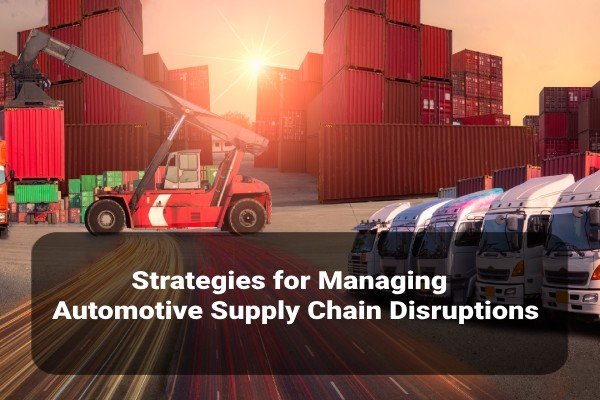Strategies for Managing Automotive Supply Chain Disruptions

The automotive industry is a linchpin of the global economy, driving economic growth, providing jobs, and shaping the future of transportation. This industry has been experiencing a lot of supply chain disruptions in recent years. The automotive supply chain has been hit by natural disasters, political conflicts, pandemics, and component shortages.
Contents
Understanding Automotive Supply Chain
The automotive supply chain refers to the intricate network of manufacturers, suppliers, logistics providers, and distributors involved in the production and distribution of vehicles and their components. From the initial design and manufacturing stages to the delivery of vehicles to dealerships and, ultimately, to customers, it involves the flow of raw materials, parts, and finished products.
Types and Impacts of Supply Chain Disruptions
Natural Disasters
Supply chains can be disrupted by natural disasters like earthquakes, hurricanes, floods, and wildfires. As a result, raw materials and finished products can be delayed, causing production to slow down and costs to go up.
Man-made Disruptions
Strikes, political instability, terrorism, and civil unrest are all man‑made disruptions. This can affect international trade, disrupt manufacturing operations, and create supply chain bottlenecks, affecting production and distribution.
Supplier Issues
Supply chain disruptions can happen for a variety of reasons, such as bankruptcy, quality issues, or sudden production stoppages. Relying heavily on one supplier can make a supply chain more vulnerable.
Demand Fluctuations
Supply chain disruptions can happen when demand patterns change, like during COVID-19. It’s hard for companies to respond effectively when demand increases or decreases rapidly, because inventory levels, transportation capacity, and production capacity can be squeezed.
Technological Disruptions
It’s possible to enhance and disrupt supply chains with advances in technology. Automation, Internet Of Things (IoT), and data analytics can improve supply chain efficiency, but they also bring new risks, like cybersecurity threats and system failures, that can mess up operations and data.
This disruption can have a huge impact on your business. It could cause your costs to go up, your customer satisfaction to go down, your sales to go down, your reputation to suffer, and even your business to go out of business. To mitigate the impact of disruptions, businesses need to have robust risk management strategies and built their supply chains to be resilient.
Strategies to Build a Disruption-proof Supply Chain in Automotive Industry
Risk Assessment and Mitigation
The automotive supply chain needs to be assessed and mitigated. In order to identify vulnerabilities, a comprehensive supply chain evaluation is necessary. Regular supplier audits, supply chain mapping, and knowing dependencies are all important.
By conducting risk assessments, you can quantify how likely and how damaging potential disruptions are. Scenario planning and risk quantification help you prepare for anything.
It’s important to have well-documented disaster plans, including cross-functional response teams, so you can act fast when things go wrong. Lastly, supplier diversification and redundancy reduce dependence on a single source, give backup options for critical components, so your supply chain is more resilient. The automotive supply chain is protected from unexpected challenges by these strategies.
Resilient Supply Chain Design
In order to thrive in the automotive industry despite disruptions, a resilient supply chain design is crucial. The goal is to switch from Just‑in‑Time (JIT) to Just-in-Case (JIC) inventory management which allows critical components to be stockpiled to cover unforeseen shortages.
In addition, implementing agile and flexible supply chain structures allows for swift responses to changing conditions. It also reduces reliance on distant suppliers, so transportation vulnerabilities are minimized.
Using IoT and data analysis, you can monitor in real time, see where your supply chain is and make smarter decisions. Together, they strengthen the automotive supply chain, boosting its resilience in an ever‑changing world.
Collaboration and Communication
Building relationships with suppliers and partners fosters trust and facilitates smoother interactions during disruptions, bolstering supply chain resilience.
Establishing clear communication channels ensures that information flows seamlessly throughout the supply chain, allowing for rapid responses to challenges. Collaborative forecasting and demand planning involve sharing data and insights, enabling more accurate predictions and synchronized production.
Cross‑functional crisis teams bring experts from different departments together to respond quickly to disruptions and implement contingency plans. In order to survive disruptions and maintain a resilient supply chain, the automotive industry needs to embrace these collaborative and communicative strategies.
Technology and Digitalization
The automotive supply chain needs to integrate technology and digitalization in an era of rapid technological advancement. IoT and sensors optimize supply chain visibility by giving you real-time insight into what’s moving and what’s not.It’s possible to identify equipment issues and reduce downtime by using machine learning and Artificial intelligence (AI) in logistics with blockchain technology.
Additionally, robotics and automation improve processes, improve efficiency, and cut down on human labor. In order to make its supply chain operations more resilient, the automotive industry needs to embrace these technological innovations.
In conclusion, It’s vital for the continued success and resilience of the automotive industry to manage disruptions in the supply chain, from natural disasters to technological advances. In an ever-changing landscape of automotive supply chain disruptions, the industry is well positioned to navigate disruptions with agility, ensuring uninterrupted production, and safeguarding its position as a linchpin of the global economy.









